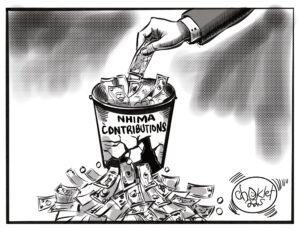This article makes an argument that whilst COVID-19 has unleashed a new wave, causing confirmed cases and in some cases deaths to rebound, lockdowns are no longer fashionable. And that national policy responses need to take a long-term perspective with efforts aimed at rebuilding the economy should emphasise local solutions such as: food sovereignty, small-scale agricultural investments, and agro-ecology. The interplay between what is characterised as the financial economy and the real economy is very crucial in that the former subordinates the latter as was witnessed in 2020.
As with other countries in sub-Saharan Africa, Zambia has since early 2020 implemented COVID-19 containment measures, with a few experimentations of lock downs in Kafue and Nakonde. But how effective are lockdowns? Should Zambia consider lockdowns? Addressing the former questions require that we learn from regional experiences, and tease insights from COVID-19 cases vis-a-vis lockdown. What seems to be the most affected country on the continent is South Africa – an important import source for Zambia.
It was reported that at the start of October, the World Health Organisation (WHO) and the Chinese government lauded South Africa’s response to the global COVID-19 pandemic. Yet data concerning both the spread of the virus and the indirect consequences of the lockdown suggest that the severe restrictions imposed in South Africa – some of the strictest in the world – were far from effective. Indeed, a recent review by Professor Benjamin Smart and Co-workers at University of Johannesburg reveal that at the end of December, South Africa accounted for more than 70% of new weekly cases in its Africa region (this excludes Morocco, Tunisia, Libya, Egypt, Sudan, Djibouti or Somalia). In the SADC region, recent review show that by 8th January 2021, the following status prevailed:
Table 1: SADC COVID-19 status update, not ranked in order(08.01.2021, Accessed 8th January 2021)

Among 12 countries in the region, Zambia ranked 5th in terms of confirmed cases and 3rd in terms of deaths (433), competing with South Africa (441) and DRC (610). South Africa and DRC both experimented with lockdowns and state of health emergency.
More broadly, ten countries account for about 70% of the total tests conducted so far – South Africa, Morocco, Ethiopia, Egypt, Kenya, Nigeria, Cameroon, Rwanda, Uganda and Ghana. Zambia does not feature here, yet it competes on cases and casualties. Recent review of evidence for the effectiveness of the lockdown at slowing the spread of the pandemic conducted at University of Johannesburg, show the mitigation strategies initially implemented may well have gone some way to “flattening-the-curve” – that is, reducing the rate at which the virus spreads through the population. However, the review found no decline in either daily new cases or deaths between around 27th March, which was the first day of level 5; and the latter part of July, when cases began to tail off during level 3. They note that the lockdown level 5 in South Africa was one of the world’s strictest. Citizens were not allowed to leave their residence except for essential purposes such as grocery shopping and medical care. All non-essential businesses were shut down, and cigarette and alcohol sales were banned. They ask a crucial question: If this “hard lockdown” had been effective, the rate of infection would have dropped significantly 7-14 days after lockdown was implemented. Note that one must look for a delay due to the disease’s 5-6-day average incubation period, and time for test results to be released. The conclusion is that this simply did not happen.
From a public health perspective, it remains unclear the effectiveness of lockdowns and other stricter social containment measures – they are simply less fashionable. Maybe the solution lies elsewhere – a feature for more robust research and futuristic planning approaches. Whilst the economic costs of lockdowns are massive, they won’t just cut the mustard for Zambia and probably other countries in the region. A key lesson from Tanzania exists here: the country recorded 509 confirmed cases with 21 deaths, yet Tanzania never went into lockdowns such as witnessed in South Africa, DRC and Zambia. In fact, early on in 2020 John Magufuli declared Tanzania free of COVID-19, thanks to God, with the WHO casting doubts over the Tanzanian miracle gods. Fergus Kell of Chatham House writes: “Tanzania’s COVID-19 containment measures have been markedly less strict than many neighbouring states, where lockdowns and travel restrictions have largely become the norm…….daily life for the majority of working citizens has been minimally affected.”
As with South Africa, it is easy to be right after the fact. Regional experiences help us to see that lockdowns would be unfeasible in much of Zambia. The structure of the Zambia’s economy, culture and livelihood strategies among most Zambians all substantially changes any effect of lockdowns. What about the deteriorating financial economy? It is clear the health consequences of such interventions were likely to be more damaging economically than the virus itself. Lockdowns might work in some areas but cannot be transplanted in their entirety. Same applies to the COVID-19 vaccine. It is interesting that even with overwhelming cases and casualties of COVID-19, there seems little wide acceptance of the COVID-19 vaccine in the west and USA. Africa and Zambia inclusive will have to move prudently and gradually on this front, at least as they remain on the periphery of the COVID-19 pandemic. A focus on economic recovery would be very crucial, and domestic building blocks such as food sovereignty agenda, Small to Medium Scale Enterprises, and agro-ecological approaches will be crucial.
About the Author: Dr Simon Manda is CTPD Senior Researcher for Trade and Development and is a Lecturer at the University of Zambia Department of Development Studies. He is a Visiting Research Fellow at Oregon State University, USA.

























One Response
There need not be contradiction between short term measures such as lock down, school closure, suspension of huge gatherings for worship service or political rallies and wide long term measures. By long term measures, reference is made to improvements in local health and hygiene standards through collaboration between government and community partners. Any direct attacks on lock down at this critical juncture of the pandemic is likely to confound the population. It is necessary for members of the public to wash hands, sanitize hands, and wear face masks and to maintain social distance. The case of Sweden proves that the public misunderstood self discipline as permissiveness. laughing at the king is misguided. It is better to combine the two approaches, namely self discipline and national measures. Much as consultative meetings between representatives of business and public health department, between civil society and public health department, between public service workers and public health department, it is necessary to follow directives first and then to make consultation afterwards. If items for inclusion in long term plans are available, then it is vital to urgently submit them to public health department for immediate consideration. In final analysis, health practitioners need to be accorded benefit of doubt. Professional errors would be dealt with by capable professional disciplinary bodies. It is all about division of labor. Take time to support health practitioners. Take time to support local communities. Take time to support development partners.